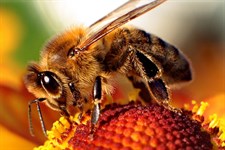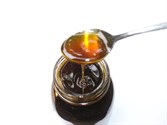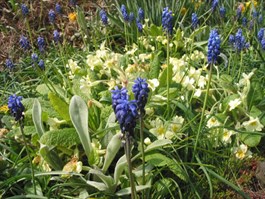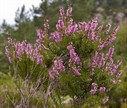Honey bees are
thought to be responsible for about a third of pollination of food
crops in UK. They have been of vital importance to the ecosystem of
the world for thousands of years. Man has been collecting honey
from wild bees for centuries. Bees collect nectar and pollen from
all sorts of flowering plants, this forage is vital for them to
survive and for honey production. There are hundreds of flowers,
vegetables, trees and shrubs which are pollinated by bees and other
insects.
 Bees
need a mixture of pollen and nectar. The pollen is necessary for
raising the young. They collect this in 'pollen sacks' on their
legs.
Bees
need a mixture of pollen and nectar. The pollen is necessary for
raising the young. They collect this in 'pollen sacks' on their
legs.
There are many bee species in the UK. The various varieties of
bumble bees are able to fly at lower temperatures and in wetter
conditions than honey bees and so are valuable pollinators as
well.
In the winter bees tend to huddle together in the hive or colony
and feed off the stores of honey and pollen collected in the
season. They usually collect much more than they can use for a
whole winter and so we can take some of this. We must make sure
they have plenty to survive the winter though.

A single honey bee makes no more than a teaspoon of honey in its
lifetime. They prefer foraging one crop at a time, so it's
advisable to plant clusters of one type of flower rather than lots
of individually bee- friendly plants. Bees also seem to prefer
plants with small clusters of flowers such as Sedums.
Bees begin to forage for food in February usually but
occasionally they will go out earlier in good weather. Some of the
earliest garden flowers are hellebores,
crocuses and snowdrops, a useful source of
pollen and nectar after a long winter. Daffodils unfortunately are
not good for bees.
 Some good
spring flowers are bluebells and primroses. There are too many
to list here. Of course a good late spring 'weed' for bees is
dandelion. Not most gardener's best friend, but
bees love them. This spring I saw a local organic farm with two
fields absolutely covered in them- beautiful.
Some good
spring flowers are bluebells and primroses. There are too many
to list here. Of course a good late spring 'weed' for bees is
dandelion. Not most gardener's best friend, but
bees love them. This spring I saw a local organic farm with two
fields absolutely covered in them- beautiful.
One of the big spring agricultural crops for bees is oil
seed rape. This gives bees a massive monocrop for a short
period and much honey is made. However, the honey crystalizes very
quickly, so has to be taken off the hive as soon as possible as it
goes hard if left on.
Following on is hawthorn in the hedgerows and apple
blossom time. Commercial beekeepers are paid to
pollinate apple orchards and many other fruit and vegetable crops.
Hives are moved to crops as needed.
Through the summer cotoneaster is a very good
garden plant for bees. In the vegetable realm beans
are good forage from broad beans to runner beans. Most
herbs are also excellent for bees.
Thyme is a particularly good plant, easy to grow
in dry soils and it makes pretty and aromatic ground cover.
 Later in the year towards the end of
summer the main honey flow is from brambles and if
grown maize is a good pollen source. If bees are
near waterways, there is usually the Himalayan Balsam, which
despite naturalists' dislike of it, is fabulous for bees. Heather is a late summer
source of forage as is ivy, although, like oil
seed rape, ivy honey crystalizes easily and may become too
granulated for the bees to use through winter. In fact one of my
colonies of bees died last winter from starvation even though their
hive was full of ivy honey that had all crystalized.
Later in the year towards the end of
summer the main honey flow is from brambles and if
grown maize is a good pollen source. If bees are
near waterways, there is usually the Himalayan Balsam, which
despite naturalists' dislike of it, is fabulous for bees. Heather is a late summer
source of forage as is ivy, although, like oil
seed rape, ivy honey crystalizes easily and may become too
granulated for the bees to use through winter. In fact one of my
colonies of bees died last winter from starvation even though their
hive was full of ivy honey that had all crystalized.
For more information you can go to the British Bee Keepers Association, the Royal Horticulture Society and there are
now many good books such as Ted Hooper and Mike Taylor's: The Bee Friendly Garden.
To conclude, when planting your garden, perhaps think on the
importance of all the pollinators and that if they disappear we
will be left without the wonderful diversity of flowers and
vegetable, meat and dairy produce we have today. We would also be
left without one of the most beneficial, tasty and mystical
substances of all - honey!